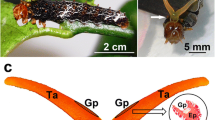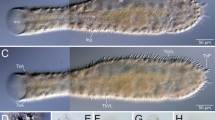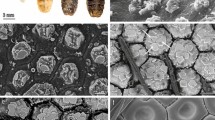Summary
The cytological modifications of the epidermal cells secreting sternal and pleural cuticle of adultTenebrio are studied, specially during the formation and evolution of the outer and inner epicuticle.
Both layers are secreted by condensation of diffuse material just above the epidermal microvilli. There is no peculiar phase without microvilli when inner epicuticle is formed.
During the secretion of pre-ecdysial cuticle, the epidermal cell is characterized by an heterolytic process which is demonstrated by peroxidase injection into the ecdysial space: horseradish peroxidase is absorbed by large pinocytic coated vesicles which discharge their content into multivesicular bodies, after the loss of their coat. The intensity of pinocytosis is studied by vesicles counts at different stages of the pupal life. These counts show a pinocytic peak when the inner epicuticle is formed.
When the epicuticular barrier is completely secreted, exogenous peroxidase is no more absorbed, but morphological study and counts show that pinocytosis still occurs.
This demonstrates that epidermis cannot absorb macromolecules arising from the digested old cuticle since digestion occurs after the completion of adult epicuticle. Locke's hypothesis about the “control of the extracellular subcuticular environment” by pinocytosis is confirmed.
The Golgi complexes are involved in lytic process with their small coated vesicles and in secretion of cuticular material with their large dense secretory vesicles, but according to vesicle counts, the secretory vesicles are not concerned in epicuticle formation since their apparition is posterior to the deposition of the inner epicuticle.
Résumé
Les modifications cytologiques des cellules épidermiques sécrétant la cuticule sternale et pleurale de l'adulte deT. molitor sont étudiées pendant la formation et l'évolution de l'épicuticule externe et interne.
L'épicuticule externe et interne sont sécrétées de la même façon par condensation de matériel diffus au-dessus de l'apex des microvillosités.
Un cycle hétérolytique est mis en évidence par l'emploi de peroxydase injectée dans l'espace exuvial: la peroxydase est captée par de grosses vésicules revêtues et incorporée dans des corps multivésiculaires apicaux. Par comptage des différentes populations de vésicules, des variations nettes dans l'intensité de la pinocytose sont mises en évidence. Ces variations semblent en rapport non pas avec la digestion de l'ancienne cuticule mais avec les différences de nature et de structure des composants cuticulaires. L'hypothèse du contrôle de la sécrétion épidermique par les phénomènes de pinocytose énoncée par Locke (1969) est confirmée.
Des vésicules d'origine golgiennes sont secrétées surtout après la formation de l'épicuticule et ne sont donc pas à l'origine du matériel épicuticulaire, mais il est possible qu'elles jouent un rôle dans l'évolution ultérieure des structures épicuticulaires.
Similar content being viewed by others
Bibliographie
Beaulaton, J.: Modifications ultrastructurales des trachées et genèse des petites trachées et trachéoles chez le Ver à soie. J. Microscopie7, 621–646 (1968).
Bowers, B.: Coated vesicles in the pericardial cells of the aphid (Myzua persicae Sulz.). Protoplasma (Wien)59, 351–357 (1964).
De Duve, C., Wattiaux, R.: Functions of lysosomes. Ann. Rev. Physiol.28, 435–492 (1966).
Delachambre, J.: La réaction de la chitine à l'acide périodique-schiff. Histochemie20, 58–67 (1969).
—: Etudes sur l'épicuticule des Insectes. I. Le développement de l'épicuticule chez l'adulte deTenebrio molitor L. Z. Zellforsch.108, 380–396 (1970).
Farquhar, M. G., Palade, G. E.: Cell junction in amphibian skin. J. Cell Biol.26, 263–291 (1965).
Filshie, B. K., Waterhouse, D. F.: The structure and development of a surface pattern of the cuticule of the green vegetable bugNezara viridula. Tissue and Cell1, 367–385 (1969).
Friend, D. S., Farquhar, M. E.: Functions of coated vesicles during protein absorption in the rat vas deferens. J. Cell Biol.35, 357–376 (1967).
Hollande, E.: Formation des hétérolysosomes et des cytolysomes dans les glandes multifides d'Helix pomatia (L.): étude ultrastructurale du processus de réabsorption de glycoprotéines. C. R. Acad. Sci. (Paris)268, 341–344 (1969).
Hundertmark, A.: Die Entwicklung der Flügel des Mehlkäfers,Tenebrio molitor, mit besonderer Berücksichtigung der Häutungsvorgänge. Z. Morph. Ökol. Tiere30, 506–543 (1936).
Jeuniaux, C.: Chitine et chitinolyse, 181 p. Paris: Masson et Cie 1963.
Lawrence, P. A.: Development and determination of hairs and bristles in the milkweed bug,Oncopeltus fasciatus (Lygaeidae). J. Cell Sci.1, 475–498 (1966).
Locke, M.: The structure and formation of the cuticulin layer in the epicuticle of an insect,Calpodes ethlius (Lep. Hesp.). J. Morph.118, 461–494 (1966).
- The localization of a peroxidase assocviated with the formation of hard cuticle in insects, 26th Annual Proceedings EMSA (1968).
—: The structure of an epidermal cell during the development of the protein epicuticle and the uptake of molting fluid in an insect. J. Morph.127, 7–40 (1969a).
—: The localization of a peroxidase associated with hard cuticle formation in an insect,Calpodes ethlius Stoll. (Leptidoptera, Hesperiidae). Tissue and Cell1, 555–574 (1969b).
Noble-Nesbitt, J.: The cuticle and associated structures ofPodura aquatica at the moult. Quart. J. micr. Sci.104, 369–391 (1963).
Overton, J.: The fine structure of developing bristles in wild type and mutantDrosophila melanogaster. J. Morph.122, 367–380 (1967).
Passonneau, J., Williams, C. M.: The moulting fluid of theCecropia silkworm. J. exp. Biol.30, 545–560 (1953).
Paweletz, N., Schlote, F. W.: Die Entwicklung der Schmetterlingsschuppe beiEphestia kühniella Zeller. Z. Zellforsch.63, 840–870 (1964).
Rambourg, L., Leblond, C. P.: Electron microscope observations on the carbohydrate rich cell coat present at the surface of cells in the rat. J. Cell Biol.32, 27–53 (1967).
Rinterknecht, E., Levi, P.: Etude au microscope électronique du cycle cuticulaire au cours du 4ème stade larvaire chezLocusta migratoria. Z. Zellforsch.72, 390–407 (1966).
Smith, R. E., Farquhar, M. G.: Lysosome function in the regulation of the secretory process in cells of the anterior pituitary gland. J. Cell Biol.31, 319–347 (1966).
Stellwaag-Kittler, F.: Zur Physiologie der Käferhäutung. Untersuchungen am MehlkäferTenebrio molitor L. (Ins. Col.). Biol. Zbl.73, 11–49 (1954).
Taylor, R. L., Richards, A. G.: Intersegmentary changes during moulting of arthropods with special reference to the subcuticle and ecdysial membrane. J. Morph.116, 1–22 (1965).
Thierry, J. P.: Mise en évidence des polysaccharides sur coupes fines en microscopie électronique. J. Microscopie6, 987–1018 (1967).
Wigglesworth, V. B.: The physiology of the cuticle and of ecdysis inRhodnius prolixus with special reference to the function of the oenocytes and the dermal glands. Quart. J. micr. Sci.76, 269–318 (1934).
—: The structure and deposition of the cuticle in the adult mealworm:Tenebrio molitor L. Quart. J. micr. Sci.89, 197–217 (1948).
Author information
Authors and Affiliations
Additional information
Nous tenons à remercier notre directeur de recherche, le Professeur Noirot pour ses encouragements et ses conseils et Madame Curie pour son aide technique efficace.
Rights and permissions
About this article
Cite this article
Delachambre, J. Etudes sur l'épicuticule des insectes. Z.Zellforsch 112, 97–119 (1971). https://doi.org/10.1007/BF00665624
Received:
Issue Date:
DOI: https://doi.org/10.1007/BF00665624




